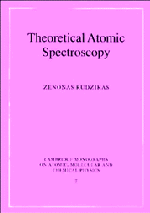Book contents
- Frontmatter
- Contents
- Preface
- Foreword to the Paperback Edition
- Introduction
- Part 1 Energy Spectrum of Many-electron Atom. Radiative and Autoionizing Transitions (Initial Formulas)
- Part 2 Foundations of the Angular Momentum Theory. Graphical Methods
- Part 3 Description of Complex Electronic Configurations
- Part 4 Second-quantization in the Theory of an Atom. Quasispin and Isospin
- Part 5 Matrix Elements of the Energy Operator
- Part 6 Electric and Magnetic Multipole Transitions
- Part 7 Calculation of Energy Spectra and Electronic Transitions in the Case of Complex Configurations
- Epilogue
- References
- Index
Foreword to the Paperback Edition
Published online by Cambridge University Press: 21 September 2009
- Frontmatter
- Contents
- Preface
- Foreword to the Paperback Edition
- Introduction
- Part 1 Energy Spectrum of Many-electron Atom. Radiative and Autoionizing Transitions (Initial Formulas)
- Part 2 Foundations of the Angular Momentum Theory. Graphical Methods
- Part 3 Description of Complex Electronic Configurations
- Part 4 Second-quantization in the Theory of an Atom. Quasispin and Isospin
- Part 5 Matrix Elements of the Energy Operator
- Part 6 Electric and Magnetic Multipole Transitions
- Part 7 Calculation of Energy Spectra and Electronic Transitions in the Case of Complex Configurations
- Epilogue
- References
- Index
Summary
General remarks
Ten years have elapsed since first publication of this monograph. This may, at first glance, seem a very short time in what has been a very stable area of fundamental physics. But the last decade has seen unprecedented technological progress and socio-economic changes. Have there been radical changes in “Theoretical Atomic Spectroscopy” in that time?
The answer is very much “yes”. Just a few examples driving current interest in this subject are:
In the explosively growing nanoscience area we are approaching the molecular and atomic scales where quantum mechanical effects become significant. This is opening new horizons in the nanotechnologies, including quantum computing and quantum cryptography.
In astrophysics, there has been a requirement for much improved spectroscopy of highly charged ions.
The practical considerations necessary for building thermonuclear power plants (driven through ITER, DEMO and other projects) require deeper insight into the structure and properties of ions, atoms and their separate isotopes.
Progress in fission research, particularly in the development of higher efficiency reactors, in radioactive waste management, in transmutation studies and transuranic elements have contributed substantially to a renewed interest in the structure and properties of complex many-electron atoms and ions of arbitrary ionization.
Even before publication of the first edition of this book it became obvious to me that there was more that needed to be said. A very important development had been the formulation and practical implementation of a new version of Racah algebra based on the second-quantization method in the coupled tensorial form, angular momentum theory in three spaces (orbital, spin and quasispin) and a generalized graphical technique.
- Type
- Chapter
- Information
- Theoretical Atomic Spectroscopy , pp. xv - xxPublisher: Cambridge University PressPrint publication year: 1997

